A constant for competitive teams is pitching. One of the biggest markets for this deadline is reliable bullpen arms capable of high-leverage situations. This article discusses multiple under-the-radar pitchers ready to fill this role for playoff teams or help a team make it down the stretch. These pitchers are putting up quality seasons, possess unique attributes, and are not mentioned frequently in public discussions. I will also float teams that seem like good fits for the players mentioned, given their current situations, player ‘types’, and player development.
Jimmy Herget
Jimmy Herget, 31, is a journeyman reliever (RP). Once a trusted arm in the Angels’ bullpen, he posted poor results in 41.1 innings pitched (IP) over the last two years. Even with disappointing results, analytically inclined teams claimed Herget and gave him tryouts at various points. Although the Rockies make some of the most questionable decisions in baseball, they claimed Herget off waivers from the Cubs, giving him an extended look for 2025 — and he’s repaid them in full: 2.89 ERA / 53 IPs / 43 Ks.
Drilling down further, he’s pitched to a 1.23 ERA / 22 IPs / 14 Ks on the Road. Although the underlying stats tell a different story about how he’s getting success (not great K-BB%, avg. whiff%, or poor GB%), Herget has historically had above-average command and elite contact suppression skills. While he’s average in some categories, I think Herget is a great change-of-scenery candidate and has shown significant improvement this year, especially in his arsenal versatility.
A sidearm supinator with low extension, Herget creates one of the more unique looks in the MLB. His arsenal includes a sweeping curveball (CU), a gyro slider (SL), a sinker (SI), a four-seam fastball (4S), and a changeup (CH). Herget’s recent success relates to his increase in SL usage. He’s relied heavily on the CU/SI combo over his career, which led to a phenomenal 2022 season. The new SL and its use not only bridge the gap between the two offerings but also create an additional threat of his SL. This newer pitch also helps with his struggles against left-handed batters (LHB) because of the arsenal’s extreme East-West nature. He also spins the CU ~3000 rpms, possessing above-average ability to spin the baseball and manipulate his wrist position to create pitch shapes (hence the other shapes as well).
Herget’s changes are pretty standard for an RP. There is some shape manipulation available, but the easiest fix is his pitch usage. For RHBs, I’d increase CU and 4S 0–0 and more 4Ss in 2Ks. For LHBs, I’d bring up the SL use 0–0, leverage more SL behind in the count, and use more 4S in 2Ks. Even without changes to his season, Herget would be a valuable arm as the shapes will play better away from Coors, and he’s shown significant improvement. He doesn’t have options; however, he becomes a free agent in 2028.
Possible Destinations: Tampa Bay Rays, New York Mets, or Seattle Mariners
Jake Bird
The next pitcher on the list is also a member of the Colorado Rockies: Jake Bird. Bird, 29, has a fascinating arsenal but an equally interesting baseball mind. Interviewed by Fangraphs recently, he discussed his career year with the Rockies and his changes to perform at Coors. The full piece is linked below.
In his four seasons with Colorado, Bird has displayed moments of success. Although he has a career 4.40 ERA, Bird showed durability in 2023 when he threw 89 IPs. He runs above-average to elite GB%, average in-zone rates on his SW/SI, and possesses unique pitch shapes. His contract status grants his team 2 more option years, and he becomes a free agent in 2029.
Bird is similar to Herget as a low-slot supinator limited in extension (and just like Herget, he runs his CU up to ~3000 rpms). His East-West arsenal goes SW, SI, CU, cutter (FC), and 4S. He creates a unique look through a deceptive delivery in which he ducks down and rotates through his body. His extreme supination bias, paired with his seam orientations, allows him to have a ton of deviation from his arm slot. The perfect example of this effect is his new Sweeper shape:
2024 Shape: 85.5 MPH / 3 iVB / -10 HB
2025 Shape: 84 MPH / 6 iVB / -14 HB
He’s flip-flopped the Sinker and Sweeper use, and it’s paid off, as evidenced by the jump in whiff% and K%.
Bird’s changes are also tied to pitch usage. He could design a better 4S, but that’s an off-season goal and might be difficult given where his wrist is in space at ball-release. The quick hits on Bird against RHBs are to throw more FC and CU first-pitch and less SI in 2Ks. Essentially a righty-killer, Bird struggles to get the job done v. LHBs. Bird needs the FC against LHBs. If he uses the SI, hitters will wait on it or drive it away, regardless of how much it deviates from slot. Use more FC first-pitch and more FC behind in the count. He can shape a gyro SL (which could be useful against LHBs), but I want to simplify the mix. Just like Logan Webb, Bird’s FC is fine even if it might not have the most aesthetically pleasing shape.
I will not sugarcoat it: Bird has been awful in high leverage this year. 18 Gs / 12.46 ERA / .559 SLG. Woof. He has been better in years past, and maybe it’s just a change of scenery thing. The upside and tools are there; it’s up to the acquiring team and Bird to put it together.
Possible Destinations: Seattle Mariners, Philadelphia Phillies, or Tampa Bay Rays
Shelby Miller
Shelby Miller, 34, is having a renaissance on a selling team. Although he’s been injured (currently on the IL with a forearm strain) a couple of times over the past couple of years, Miller’s potential has always been tantalizing. A top prospect and key piece in both the Jason Heyward and Ender Inciarte/Dansby Swanson trades, one could say Miller had a fine career just 5 years ago.
After being an SP for 7 years, Miller found his way to the bullpen. He bounced around on waivers for a bit but then showed a revamped arsenal with the Giants in 2022, allowing him to land a contract with the Los Angeles Dodgers (LAD) for 2023. Miller played well for LAD and parlayed that performance into a role with the Tigers; however, the injuries continue to follow Miller, particularly in his elbow. Props to the Arizona D-Backs (AZ) for signing him and believing in him, as he will net them a prospect at the deadline. His 2025 line: 1.98 ERA / 36.1 IPs / 40 Ks.
Interestingly, Miller’s success with the Dodgers and D-Backs features different usages for his pitches. Always having a great 4S, Miller used more SW in LAD and more Split-Finger (SPL) in AZ. He’s a higher-slot, pronation-biased pitcher. His 4S is a unique pitch: 95 MPH / 18 iVB / 11 HB with 7.1 ft of extension from a 5.3 release height. Coupled with its location in the upper third of the zone, Miller destroys hitters.
The main changes for Miller are leveraging more secondaries in 2Ks and developing/throwing a better gyro SL or bridge pitch. His 4S falters a bit against RHBs late in counts, which throwing more SW or SPL could alleviate. He had a cutter as his main secondary for years — this pitch would be phenomenal to re-add. It might be an off-season goal.
He’s been decent in high leverage this year (19 Gs / 4.15 ERA / .417 SLG), but I’d trust his experience heading into a postseason.
Miller has some familiarity with the teams listed below, and these teams need high-leverage arms.
Possible Destinations: Los Angeles Dodgers, Philadelphia Phillies, or Detroit Tigers
Isaac Mattson
Isaac Mattson, 30, is finally breaking out for the Pirates. He’s posted a 2.42 ERA / 22.1 IPs / 25 Ks. He performed similarly at AAA this year: 2.57 ERA / 21 IPs / 25 Ks. Mattson’s career is a strange one: he was a prospect with the Angels, he pitched with the Orioles’ AAA depth for two years, then bounced around on minor-league (MiLB) deals until landing a gig with the Pirates. Another talented pitcher on a clear seller, Mattson has a ton of control (only 0.029 years of service time) and 2 minor league options.
So how does a 30-year-old, minor-league journeyman become a potential add for a playoff contender? Although he releases from .7 ft higher and has a slightly shorter extension than Shelby Miller, both pitchers have similar strengths: they use their 4S about 65% of the time, throw a split-grip off-speed as their primary secondaries, and pummel hitters with upper third 4S locations. Mattson is leveraging his unique talents as a higher-slot pronation-biased pitcher: carry 4S and good CH.
Mattson’s delivery is also somewhat unique. He changed his starting position from his debut in 2021 to 2025 (notably his pelvis). He starts on the first-base side of the rubber and strides toward the batter, almost slightly across his body.
Although it’s more or less Mattson’s first season in an extended look, he’s had a few games in higher leverage. He’s had 8 Gs / 7.36 ERA / .500 SLG so there’s room for improvement.
Mattson’s changes stem from some pitch design more than usage because he’s posted some limited whiffs. He limits damage and SLG but lacks a second whiff pitch and struggles when he gets into 2Ks. I propose keeping the SL but spike-gripping the old CU on the two-seam (2S) tracks. He’s tried a SW shape as the whiff pitch, but there’s little feel given his arm swing/arm action. The 2021 CU was good but too slow, hence spiking the breaking ball and cueing it something like “throw it hard, think slider, PR velo, etc.”
I do wonder if there’s room to make him more cross-fire while maintaining the velocity to increase deception. This idea is an off-season project.
Possible Destinations: Philadelphia Phillies, New York Mets, or Tampa Bay Rays
Garrett Cleavinger
The last pitcher that isn’t talked about enough heading to this deadline is the only lefty on this list — Garrett Cleavinger. Cleavinger, 31, is having a great season: 2.48 ERA / 36.1 IPs / 49 Ks. He does almost everything well and has elite whiff%/K% this year: 35% and 33.3%. His arsenal is SI/SL/SW/4S/FC. The best part is he’s a free agent in 2028 and only costs $1.2 million this year.
Cleavinger has an interesting baseball story as well. He’s been a piece in two major trades: Jeremy Hellickson in 2017 and the Jose Alvarado deal in 2020. The Dodgers gave him a decent run, but injuries and the roster crunch led to his departure from the City of Angels after 2 years. The Dodgers traded him to the Rays, and Cleavinger found himself in Tampa Bay. He’s been a stud for the Rays since.
Cleavinger, a 3/4 slot supination-biased pitcher, is a mid-to-upper 90s left-hander with a deep pitch mix. All of Cleavinger’s pitches are average or above-average by eye tests, Stuff+, pitching bot, etc. The lefty has a deceptive delivery: he sinks low to the ground and hides the ball behind his back, only showing it to the batter as he releases the pitch. This deception helps the already good ‘stuff’ play up even more. The delivery isn’t without consequences — this unique movement pattern, velocity, and pitch movements lead to average to below-average in-zone rates. If he commanded the ball better and was more durable, he would be an SP3.
He’s doing well in high leverage this year: 15 Gs / 3.68 ERA / .433 SLG.
The Rays interestingly swapped Cleavinger’s pitch use from 2024 to 2025. Leaning on the SI/SL/SW combo as opposed to 4S/FC/SL has been amazing. The Rays optimized his pitch usage very well for this season. There is some room for more 4S/FC, but there’s also a reason they went away from it. It would be great to see Cleav embrace an even pitch usage to make batters gamble at the plate every time they see him. He’s the best left-handed RP people aren’t talking about.
Possible Destinations: New York Mets, Seattle Mariners, or Philadelphia Phillies
— — — — — — — — — — — — — — — — — — — — — — — — — — — — — — — — — — —
Notable Mentions: Aaron Bummer, Jose A. Ferrer, and Anthony Bender
Aaron Bummer, 31, is worth an article about his potential: uniqueness, plus shapes, above-average command, and durability. He swapped his SW for CU this year and dropped his FC. He’s a free agent in 2027 and is worth stretching out to a starter (more on that soon).
Jose A. Ferrer, 25, is a fun arm for many reasons. He has two option years, virtually no service time, and already pitches high leverage for Washington. He throws upper 90s from the left side and needs to optimize some usage. Ferrer also limits hard contact and has great command (doesn’t walk anyone, plus has above-average zone rates).
Anthony Bender, 30, is an East-West, lower-slot supinator who is also mid-to-upper 90s. Every pitch in his arsenal is above-average, and he has a funky delivery. He has 3 option years and is a free agent after 2028.
— — — — — — — — — — — — — — — — — — — — — — — — — — — — — — — — — — —
https://blogs.fangraphs.com/a-conversation-with-jake-bird-the-pitching-nerd-conquering-coors-field/
https://blogs.fangraphs.com/shelby-miller-is-still-evolving/



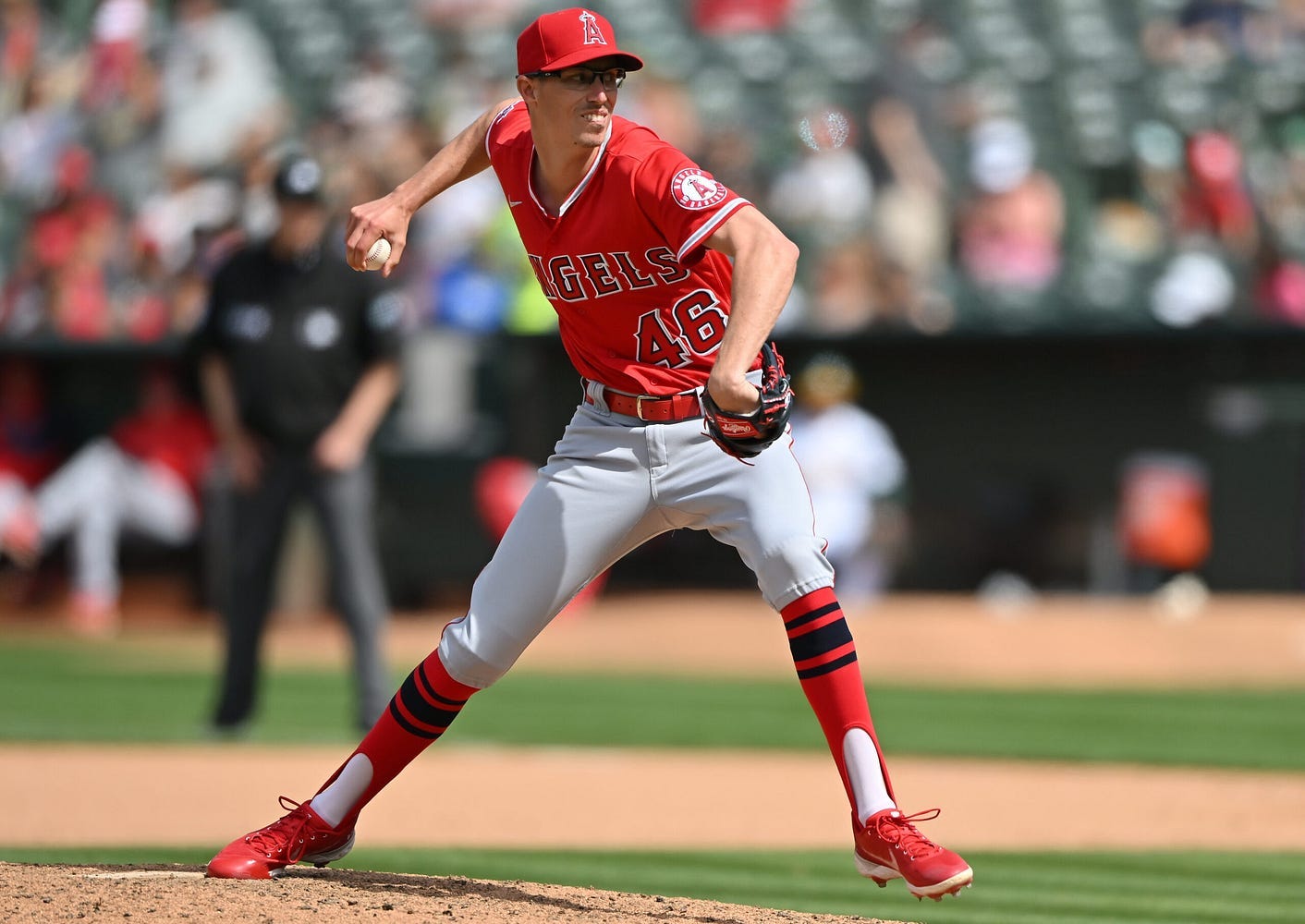
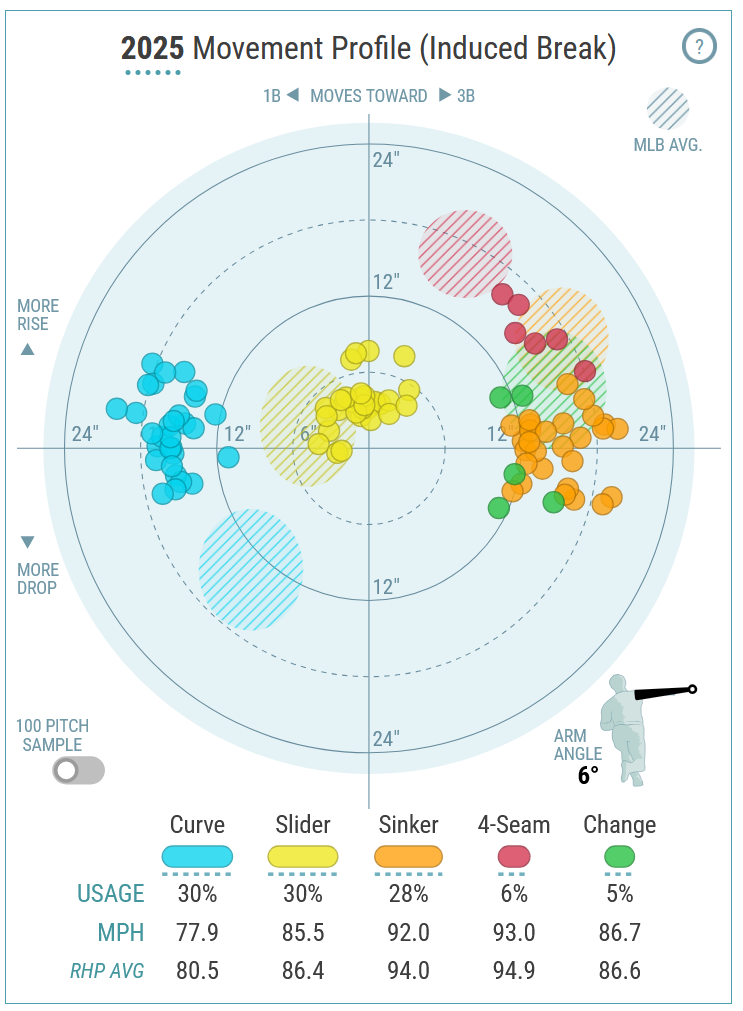
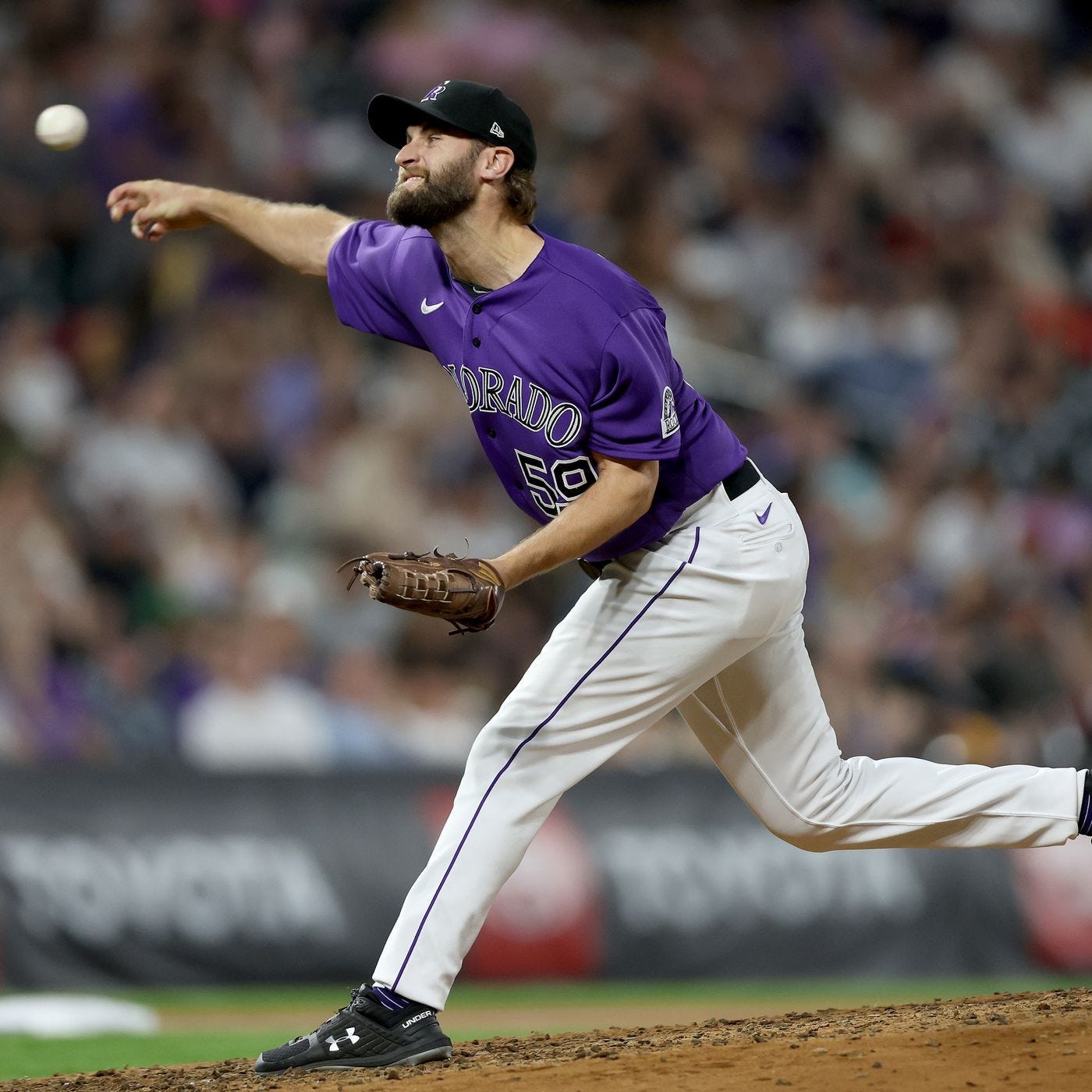
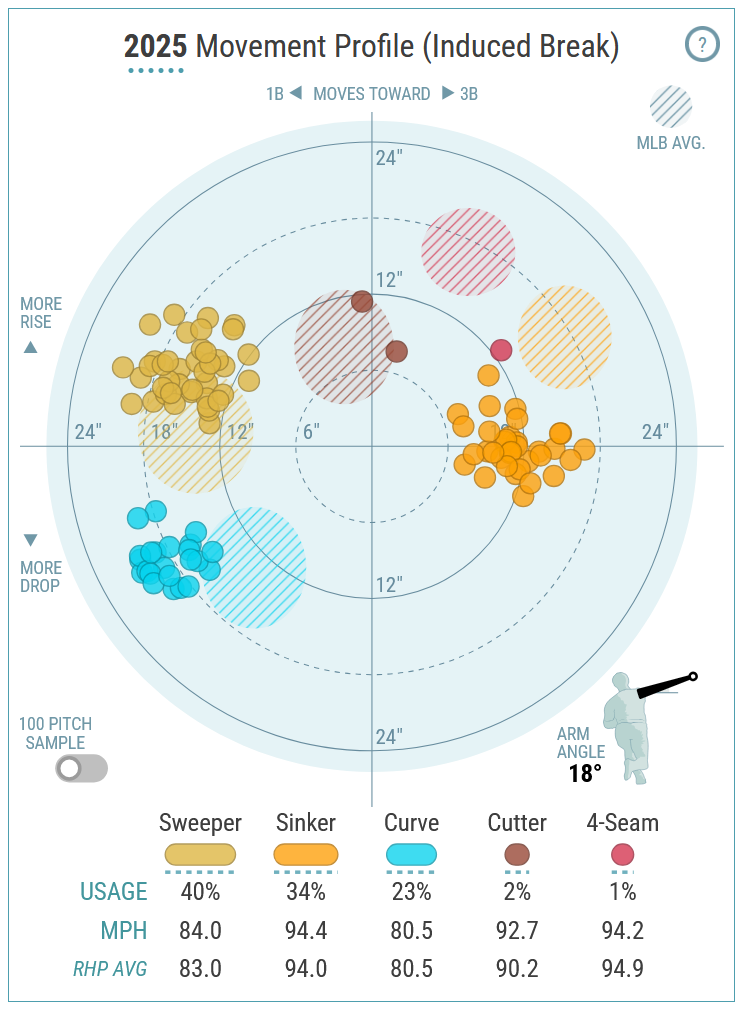
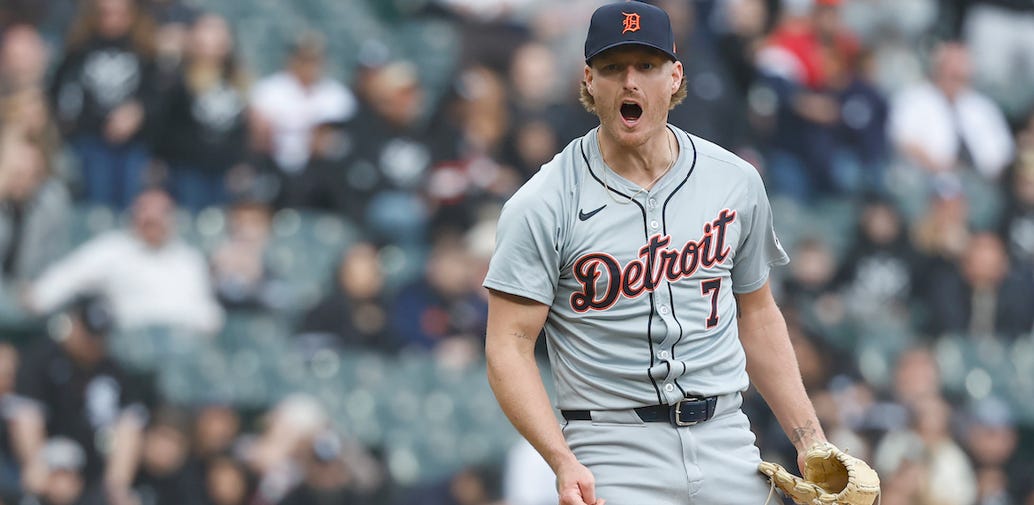
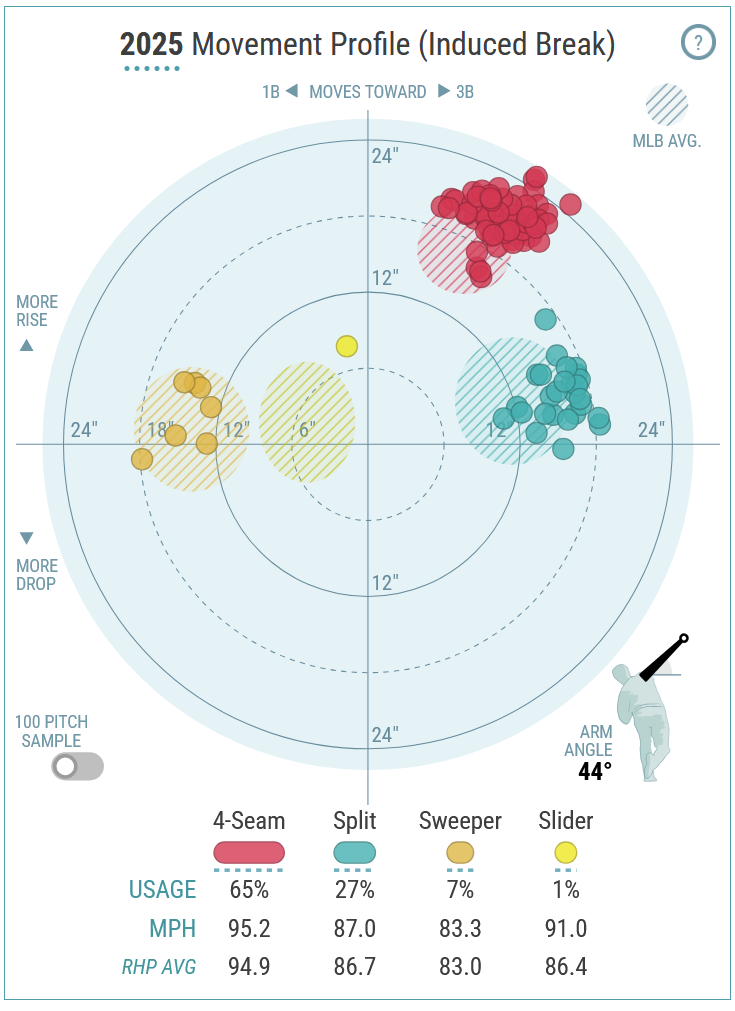
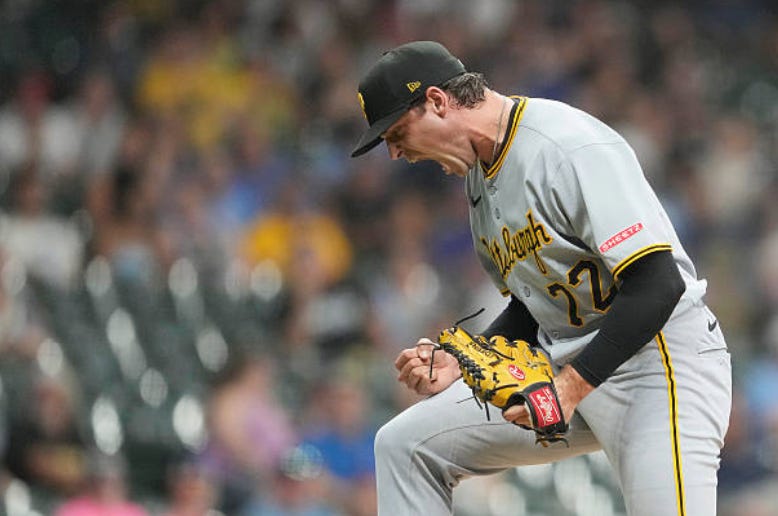

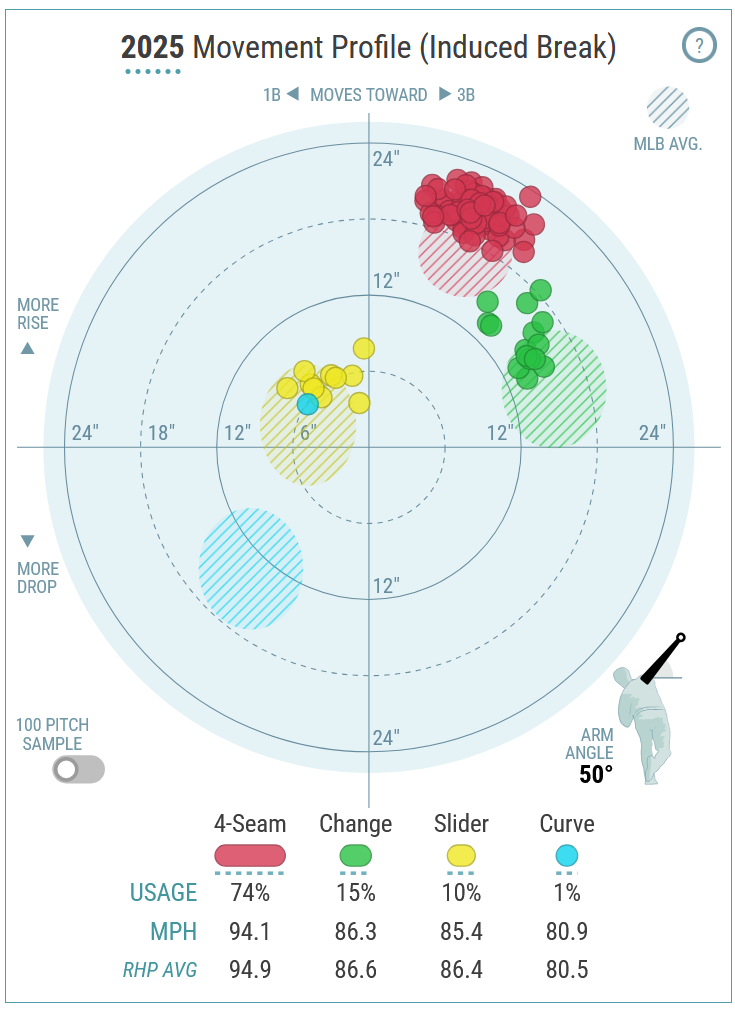
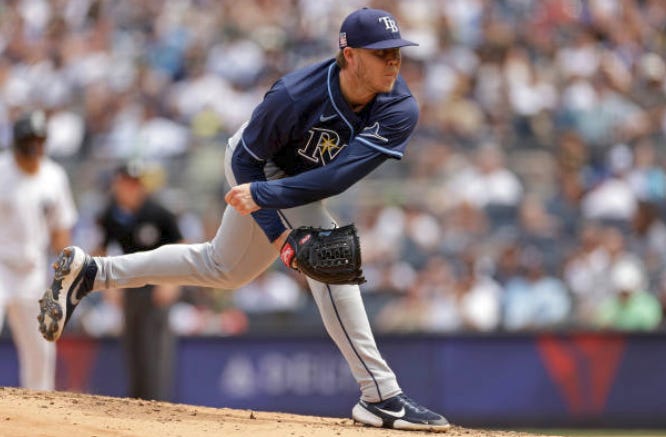
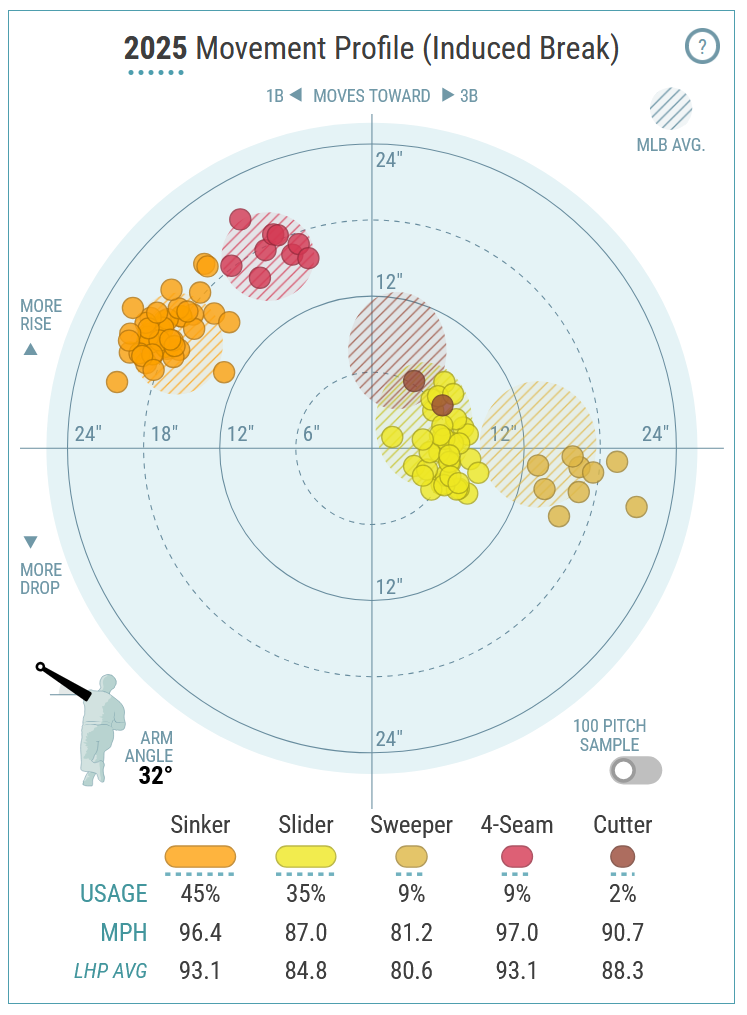
Hello! Impressive research and analysis. I think it’s great that you’re not just doing writeup’s well known players. Read one of your posts on Twitter and found you on here….Have you done profiles on starting pitchers yet? Would love to hear your thoughts on whether Eduardo Rodriguez will be better post trade deadline. Also, is Brad Lord a legit under the radar pitcher? With his arsenal, can he sustain being a 4.0-4.3 ERA starter?